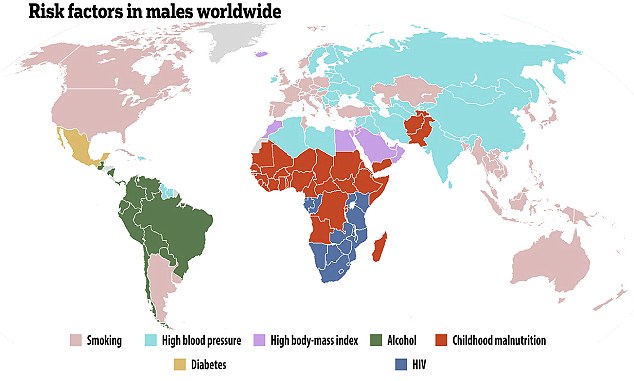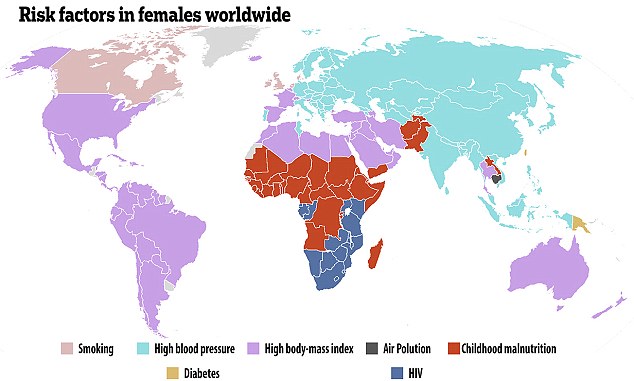- Poor diet had the greatest cumulative effect on worldwide deaths in 2013
- Unhealthy eating leads to more deaths through heart disease and diabetes
- Top risks for early deaths globally were high blood pressure and smoking
- Next top risks were high body mass index and high blood sugar levels

Poor diet is the is the biggest contributor to early deaths across the world, a study has warned.
Experts said 21 per cent of global deaths can be attributed to diets high in red meat and sugary drinks, and lacking in fruit, vegetables and whole grains.
Comment: The definition of a 'poor diet' should be more clearly addressed in the study, while it is true that sugary drinks are a concern, diets lacking in whole grains and vegetables are turing out to be better for overall health! Just a few examples of the benefits of a low carb diet examined below:
Eating unhealthily contributes to the most deaths worldwide by triggering ailments including heart disease, stroke and diabetes.
The top risks associated with the premature deaths of both men and women are high blood pressure, smoking, high body mass index (BMI), and high blood sugar levels, researchers found.
But the greatest cumulative affect on health comes from poor diet, they warned.


Overall, high blood pressure was the number one risk factor associated with global deaths, contributing to 10.4 million deaths.
It's impact on mortality has grown by more than 49 per cent since 1990, and its increasing impact has been more dramatic for men than women.
High blood pressure grew 39.9 per cent for women and 59 per cent for men.
The risk factors examined in the study contributed to a total of 30.8 million deaths in 2013, up by one-fifth from 25.1 million deaths in 1990.
'There's great potential to improve health by avoiding certain risks like smoking and poor diet as well as tackling environmental risks like air pollution,' said Dr Christopher Murray, director of the the Institute for Health Metrics and Evaluation (IHME).
'The challenge for policymakers will be to use what we know to guide prevention efforts and health policies.'
The Global Burden Disease study is recognised as the most authoritative work on global causes of disease and early death.
The research, led by the IHME and published in the Lancet journal, looked at 79 risks using data from 108 countries.
It used data from 1990 up to 2013.
The risk factors researchers analysed contributed to 30.8 million deaths in 2013, up by one-fifth from 25.1 million deaths in 1990, it found.
The mix of leading risk factors contributing to deaths has changed significantly since 1990, it said.
Childhood under-nutrition and unsafe water sources have dropped off the global top 10 list, while high cholesterol and alcohol use have replaced them as major contributors to ill health.
And the risks vary greatly for men and women.
Smoking is a larger problem for males, ranking as the number-two risk and associated with 4.4 million deaths.
For females, smoking is the number-six risk for early death, contributing to 1.4 million deaths.
Comment: While smoking is constantly being demonized, it is not as injurious to health as is portrayed, and it does not cause lung cancer. Smoking commercial cigarettes with the toxic additives and fire-safe paper is not recommended, but pure tobacco has been found to be an anti-inflammatory agent, can prevent and treat Alzheimer's and delay the onset of Parkinson's disease. For more information read about the Health Benefits of Smoking Tobacco
Similarly, alcohol is a top-10 risk factor for male deaths, but it's not a leading cause for females.
Children also struggle with different risks than adults.
For children under the age of five, child under-nutrition - which includes children who are underweight, whose growth is stunted, and who suffer from wasting (having a low weight for their height, usually due to starvation or disease) - was the number-one cause of death.
Childhood under-nutrition contributed to 1.3 million deaths in 2013, which accounts for 21.1 per cent of total under-five deaths.
Chad, South Sudan, Democratic Republic of the Congo, Somalia, and Niger were the countries with the highest proportion of deaths of children under five due to these risks.
Dr Mohammad Forouzanfar, assistant professor of global health at IMHE and the paper's lead author, said:
'While we have seen a tremendous growth in risk factors that contribute to non-communicable diseases like heart disease, pulmonary [lung] diseases, and diabetes, childhood under-nutrition remains a huge challenge for some countries.'The study examined which risk factors contribute to illness as well as early death.
Researchers use a measure known as disability-adjusted life years (DALYs), to measure the loss of health.
One DALY equals one lost year of healthy life and is measured by the sum of years of life lost to early death and years lived with disability.
The leading risk factors associated with illness in 2013 were the same as for early deaths: high blood pressure, smoking, and high body mass index.
The researchers said high blood pressure and smoking have moved up in rank since 1990, even though smoking rates have fallen in most countries.
And the overall global data masks tremendous regional variations.
In much of the Middle East and Latin America, high body mass index is the number-one risk associated with illness, they said.
In South and South East Asia, household air pollution is a leading risk, and India also grapples with high risks of unsafe water and childhood under-nutrition.
Alcohol is the number-two risk in Russia, and smoking is the number-one risk in many high-income countries, including the UK.
The most marked differences are found in sub-Saharan Africa, which, unlike other regions, is dominated by a toxic combination of childhood under-nutrition, unsafe water and sanitation, unsafe sex, and alcohol use.



Comment: Poor diet causes more disease than lack of exercise, smoking and alcohol combined, say doctors